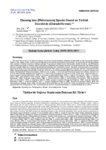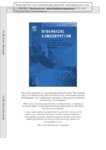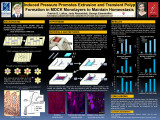1 - 25 of 21
| Creator | Title | Description | Subject | Date | ||
|---|---|---|---|---|---|---|
| 1 |
 |
Adler, Frederick R. | Alternating host cell tropism shapes the persistence, evolution and coexistence of Epstein-Barr virus infections in human | Epstein-Barr virus (EBV) infects and can persist in a majority of people worldwide. Within an infected host, EBV targets two major cell types, B cells and epithelial cells, and viruses emerging from one cell type preferentially infect the other. We use mathematical models to understand why EBV infec... | 2010 | |
| 2 |
 |
Olivera, Baldomero M. | Biochemical characterization of ?M-RIIIJ, a Kv1.2 channel blocker: evaluation of cardioprotective effects of ?M-conotoxins | Conus snail (Conus) venoms are a valuable source of pharmacologically active compounds; some of the peptide toxin families from the snail venoms are known to interact with potassium channels. We report the purification, synthesis, and characterization of ?M-conotoxin RIIIJ from the venom of a fish-... | 2010 | |
| 3 |
 |
Olivera, Baldomero M. | Defining a clade by morphological, molecular, and toxinological criteria: distinctive forms related to Conus praecellens A. Adams, 1854 (Gastropoda: Conidae) | We carried out a definition of the Conus praecellens A. Adams, 1854, species group using a combination of comparative morphological data, molecular phylogeny based on standard genetic markers, and toxinological markers. Prior to this work, Conus praecellens was generally postulated to belong to a cl... | Turriconus; 12SrRNA sequences; Phylogenetic analysis; Conus praecellens; Exogenes | 2010 |
| 4 |
 |
Shapiro, Michael D. | Divergence, convergence, and the ancestry of feral populations in the domestic rock pigeon | Domestic pigeons are spectacularly diverse and exhibit variation in more traits than any other bird species [1]. In The Origin of Species, Charles Darwin repeatedly calls attention to the striking variation among domestic pigeon breeds - generated by thousands of years of artificial selection on a s... | 2010 | |
| 5 |
 |
Ehleringer, James R.; Bush, Sarah Elizabeth | Ecophysiology of riparian cottonwood and willow before, during, and after two years of soil water removal | Riparian cottonwood/willow forest assemblages are highly valued in the southwestern United States for their wildlife habitat, biodiversity, and watershed protection. Yet these forests are under considerable threat from climate change impacts on water resources and land-use activities to support hum... | Riparian cottonwood; Riparian willow; Soil water removal; Coyote willow; Drought recovery; Populus fremontii; Riparian ecology; Red Butte Canyon Research Natural Area; Salix exigua; Stem sap flux; Leaf carbon isotope ratios | 2010 |
| 6 |
 |
Adler, Frederick R. | Effects of intraspecific density-dependence on species richness and species abundance distributions | Abstract Species richness and patterns of abundance result from the interplay between niche differences, realized as intraspecific density-dependence (IDD), and so-called neutral processes that arise when species fitnesses are similar. This paper presents an extension of neutral models that incorpo... | 2010 | |
| 7 |
 |
Bohs, Lynn A. | Eggplant origins: out of Africa, into the Orient | The eggplant (Solanum melongena L.), also known as aubergine or brinjal, has been cultivated for centuries in the Old World and is currently a crop species of global importance. Despite this, hypotheses of eggplant evolution have been fraught with controversy. Previous conclusions have relied solely... | Eggplant origins; Crop domestication; Solanum melongena complex; Solanum incanum; DNA sequence; Africa; Asia | 2010 |
| 8 |
 |
Capecchi, Mario R. | Hematopoietic origin of pathological grooming in Hoxb8 mutant mice | Mouse Hoxb8 mutants show unexpected behavior manifested by compulsive grooming and hair removal similar to humans with OCD-spectrum disorder trichotillomania. Since Hox gene disruption often has pleiotropic effects, the root cause of this behavioral deficit was unclear. Here we report that, in the b... | 2010 | |
| 9 |
 |
Capecchi, Mario R. | Hoxa1 lineage-tracing indicates a direct role for Hoxa1 in development of the inner ear, the heart and the third rhombomere | Loss of Hoxa1 function results in severe defects of the brainstem, inner ear and cranial ganglia in humans and mice as well as cardiovascular abnormalities in humans. Since Hoxa1 is expressed very transiently during an early embryonic stage, it has been difficult to determine whether Hoxa1 plays a d... | Hoxa1; Inner ear; Third rhombomere; Hindbrain; Hoxa1-IRES-Cre mouse; Embryonic development; Lineage-tracing | 2010 |
| 10 |
 |
Olivera, Baldomero M. | Identification of Conus peptidylprolyl cis-trans isomerases (PPIases) and assessment of their role in the oxidative folding of conotoxins | Peptidylprolyl cis-trans isomerases (PPIases) are ubiquitous proteins that catalyze the cis-trans isomerization of prolines. A number of proteins, such as Drosophila rhodopsin and the human immunodeficiency viral protein HIV-1 Gag, have been identified as endogenous substrates for PPIases. However, ... | 2010 | |
| 11 |
 |
Goller, Franz | Physiologically driven avian vocal synthesizer | In this work, we build an electronic syrinx, i.e., a programmable electronic device capable of integrating biomechanical model equations for the avian vocal organ in order to synthesize song. This vocal prosthesis is controlled by the bird's neural instructions to respiratory and the syringeal mot... | 2010-03 | |
| 12 |
 |
Farmer, Colleen G. | The provenance of alveolar and parabronchial lungs: insights from paleoecology and the discovery of cardiogenic, unidirectional airflow in the American alligator (Alligator mississippiensis) | Birds and mammals evolved greater aerobic abilities than their common ancestor had. This required expansion of the cardiopulmonary system's capacity for gas exchange, but while directional selection for his expanded capacity resulted in extremely similar avian and mammalian hearts, strikingly differ... | 2010-07 | |
| 13 |
 |
Ehleringer, James R. ; Cerling, Thure E. | Aberrant water homeostasis detected by stable isotope analysis | While isotopes are frequently used as tracers in investigations of disease physiology (i.e., 14C labeled glucose), few studies have examined the impact that disease, and disease-related alterations in metabolism, may have on stable isotope ratios at natural abundance levels. The isotopic composition... | 2010-07-21 | |
| 14 |
 |
Shapiro, Michael D. | Adaptive evolution of pelvic reduction in sticklebacks by recurrent deletion of a Pitx1 enhancer | The molecular mechanisms underlying major phenotypic changes that have evolved repeatedly in nature are generally unknown. Pelvic loss in different natural populations of threespine stickleback fish has occurred by regulatory mutations deleting a tissue-specific enhancer of the Pituitary homeobox t... | Adaptive evolution; Pelvic reduction; Pituitary homeobox transcription factor 1; Pitx1; Gasterosteus aculeatus | 2010-01-14 |
| 15 |
 |
Sekercioglu, Cagan | Chewing lice (Phthiraptera) species found on Turkish shorebirds (Charadriiformes) | Approximately 4.500 species of lice have been so far described, with about 4.000 species seen on birds and with 3.000 species in the suborder Ischnocera 1. There are 465 bird species so far recorded in Turkey and the actual total is likely to exceed 500 species. However, the chewing lice fauna of th... | 2010-01-01 | |
| 16 |
 |
Clayton, Dale H. | Ecoimmunity in Darwin's finches: invasive parasites trigger acquired immunity in the medium ground finch (Geospiza fortis) | Invasive parasites pose a serious threat to native animal populations, because hosts with no history of exposure may lack effective immune defenses. Invasive parasites are a particular threat to small, island populations [1,2]. For example, introduced malaria (Plasmodium relictum) has exacerbated t... | Darwins finches; Ecoimmunity; Acquired immunity; Medium ground finch; Geospiza fortis; Invasive parasites; Novel parasites; Poxvirus avium; Nest flies; Philornis downsi | 2010-01-06 |
| 17 |
 |
Sekercioglu, Cagan | The effects of climate change on tropical birds | Birds are among the most widely studied organisms on earth and represent an important indicator group for learning about the effects of climate change - particularly in regard to the effects of climate change on tropical ecosystems. In this review, we assess the potential impacts of climate change o... | 2010-01-01 | |
| 18 |
 |
Loftus, Patrick David; Rosenblatt, Jody; Eisenhoffer Jr., George Thomas | Induced pressure promotes extrusion and transient polyp formation in MDCK monolayers to maintain homeostasis | In the human body about 100,000 cells are produced every second by mitosis and a similar number die by apoptosis. What happens if too much death occurs? What happens if too little death occurs? How are dying epithelial cells removed? | Extrusion; MDCK monolayers; Polyp formation; Trapeze Interactive Poster | 2010-03-15 |
| 19 |
 |
Bohs, Lynn A. | Phylogenetic relationships in solanum section Androceras (Solanaceae) | The Leptostemonum clade of Solanum contains approximately 350-450 species, including the cultivated eggplant, S. melongena. This clade is characterized by the presence of prickles and apically attenuate anthers. Solanum section Androceras, the focus of this study, is a group of ca. 12 species belon... | 2010-12-01 | |
| 20 |
 |
Jorgensen, Erik | Protein localization in electron micrographs using fluorescence nanoscopy | A complete portrait of a cell requires a detailed description of its molecular topography: proteins must be linked to particular organelles. Immuno-electron microscopy can reveal locations of proteins with nanometer resolution but is limited by the quality of fixation, the paucity of antibodies, and... | 2010-01-01 | |
| 21 |
 |
Brunstetter, Duncan Matthew; Blair, David F. | Unlocking the switching of a nanomotor | Many pathogens use flagella as a means of locomotion. Pairs of Fli M residues were mutated and tested in the presence of repellent (forcing the motor to tumble) and differences in crosslinking were observed. Of those species, some (e.coli, salmonella etc.) can spin their flagella in 2 different di... | Pathogens; Flagella; Nanotechnology; Nanomotor; Trapeze Interactive Poster | 2010-03-15 |
1 - 25 of 21
